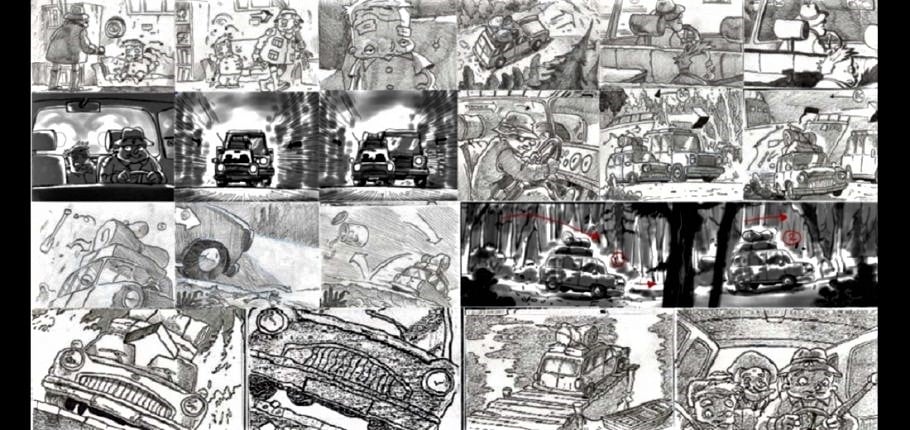Filmmakers use storyboards to provide a visual representation of a screenplay, plan a shooting schedule, or present their ideas to producers and other decision-makers. They are a great communication tool that enables the director to convey his/her vision to the cinematographer or DP, the camera crew, and other key departments.
 They can be quite complex, resembling a graphic comic book of sorts, or simple sketches that could illustrate light positions, camera angles, and other effects. Although the size is dependent on the scope of the film, most traditional storyboards feature a series of cards attached to a large board. The storyboard is also helpful when it comes to changing scenes as the order of the cards can be moved or cards can be removed completely.
They can be quite complex, resembling a graphic comic book of sorts, or simple sketches that could illustrate light positions, camera angles, and other effects. Although the size is dependent on the scope of the film, most traditional storyboards feature a series of cards attached to a large board. The storyboard is also helpful when it comes to changing scenes as the order of the cards can be moved or cards can be removed completely.
Even with the amount of graphic design software available on the market, many storyboards are still hand-drawn, even if that means using a stylus on a tablet of some sort. They may be presented in digital form, however, depending on the environment.
What is an animatic?
If you’d like to really pump up your digital storyboard, consider transferring your storyboard to your video-editing software of choice. You’ll be able to add film, dialogue, lighting effects, and more. You’ll still be using still images, but mimicking a pan effect can help add an air of movement.
By creating an animatic you can also control the time spent on each frame of the storyboard. You can create long, lingering “shots” and intersperse quick jumps into the action. When finished, you’ll have a good idea of how long your movie will be and if you need to make any edits if you find yourself with a four-hour epic.
Why is storyboarding important?
Some of the best lines—dramatic, comedic, or otherwise—are often ad-libbed. “You’re going to need a bigger boat” from Jaws, “I’m King of the World” from Titanic, and “Leave the gun, take the cannoli” from The Godfather were reportedly variations from the original script. While the occasional one-off makes a scene memorable, it’s no way to shoot an entire movie.
Shooting a film without a storyboard is kind of like giving actors no dialogue. It may work for a little bit, but eventually, everything will fall apart. Like a script, a storyboard lays out how the movie will look, how it will be shot, and how it will be shown on the screen.
It helps project potential pain points before the cast and crew show up to the set. You can see how the movie unfolds, and if a transition or scene feels out of place—or just plain bad—it can easily be removed and replaced with something different. Much easier to do that with a sticky note now than on location a few months later.
How to make a storyboard?
Storyboards can be as simple or as in-depth as you’d like them to be. At the start, you may want to start broadly, pulling out major scenes as they appear. It can be as easy as grabbing a pad of sticky notes, drawing a still, affixing to a poster board, and then moving on to the next shot.
There are also several storyboard templates online you can download and storyboarding software available to get you started. If you’re worried about not being able to draw, don’t be. Chances are, your first film or two will be small passion projects that won’t require intense storyboarding.
You just want to be able to visualize on paper what will eventually be put on screen. You can even use stick figures if you’d like. The more storyboarding you do, the better you’ll be. However, there are storyboard artists that can do the heavy lifting for you if you’ll be presenting to others.
Should You Storyboard?
Whether it’s a few rough sketches on a piece of paper or a detailed, shot by shot type of storyboard, the practice helps the production process by laying out your feature film, tv show, or video production. You’ll plan camera movements, actor positions, and other key aspects of setting a scene.
As a visual representation of the script, during preproduction your storyboard gives you and the crew an understanding of how the finished project should look. You can identify potential problems much easier than reading through a script and start planning the type of equipment you’ll need for each shot.
Just as you’d write a synopsis or a scene outline for your screenplay, a storyboard lets you plan each shot of your film well before it’s time to bring the cast and crew together. Although it may take several hours, days, or even weeks to complete, your shooting schedule will be much more efficient using a storyboard as a blueprint. This helps guide the setup of the shots and create a series of cohesive and purposeful takes that bring your story to life.
With the right experience and connections, you can jumpstart your career in the film industry. The Film Connection film school alternative is endorsed by filmmakers who are making movies, maybe even the movies you love. Professionals in the film business—including famous producers, screenwriters and directors—endorse Film Connection’s certificate programs for one simple reason: they know our real-world method works. Schedule a tour of a Film Connection film production school in your area. Read our film production school testimonials and student success stories to see how our students have turned their passion into a reality with the Film Connection program.



